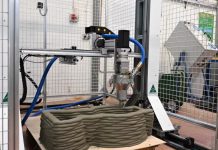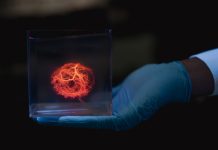Researchers at the University of Minnesota Twin Cities have fully 3D printed a flexible organic light-emitting diode (OLED) display.
The breakthrough could lead to low-cost OLED displays that could be mass-produced using 3D printers at home rather than by technicians in expensive microfabrication facilities in the future.
“OLED displays are usually produced in big, expensive, ultra-clean fabrication facilities,” said Michael McAlpine, a University of Minnesota cost OLED displays that could be mass-produced at home using 3D printers rather than by technicians Kuhrmeyer Family Chair Professor in the Department of Mechanical Engineering and the senior author of the study.
“We wanted to see if we could basically condense all of that down and print an OLED display on our table-top 3D printer, which was custom built and costs about the same as a Tesla Model S.”
By combining two different modes of printing, the researchers managed to print the six device layers that resulted in a fully 3D-printed, flexible organic light-emitting diode display after initially struggling with the uniformity of the light-emitting layers.
Next steps are to 3D print better resolution and brighter OLED displays and investigate all possible applications.
“The nice part about our research is that the manufacturing is all built in, so we’re not talking 20 years out with some ‘pie in the sky’ vision,” McAlpine said.
“This is something that we actually manufactured in the lab, and it is not hard to imagine that you could translate this to printing all kinds of displays ourselves at home or on the go within just a few years, on a small portable printer.”
The research paper entitled “3D printed flexible organic light-emitting diode displays” was published in Science Advances, a peer-reviewed scientific journal published by the American Association for the Advancement of Science (AAAS).



















